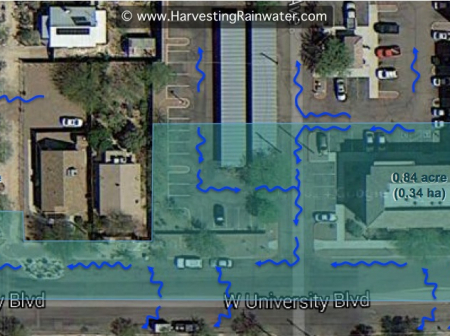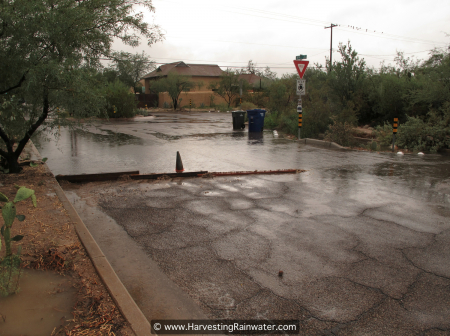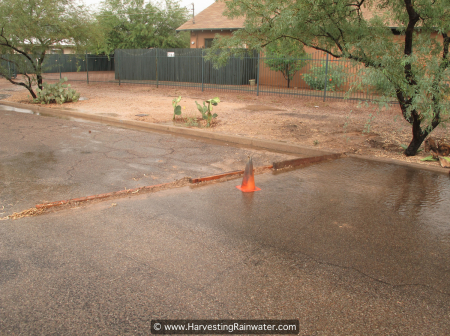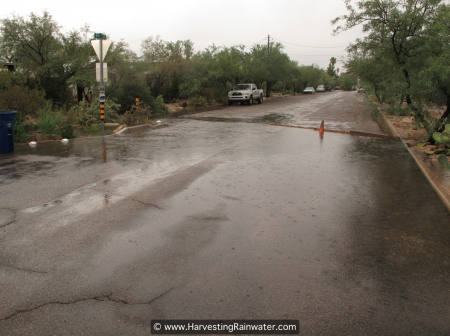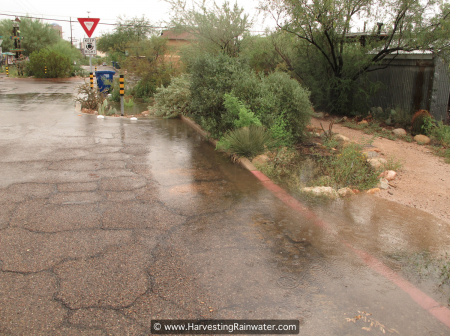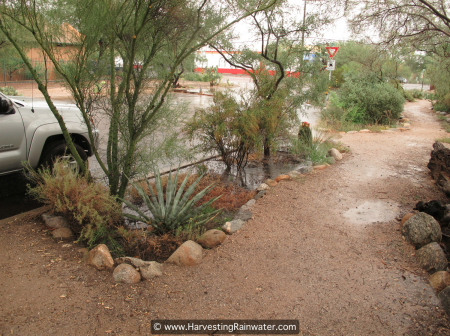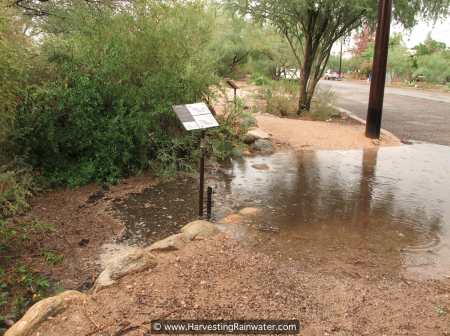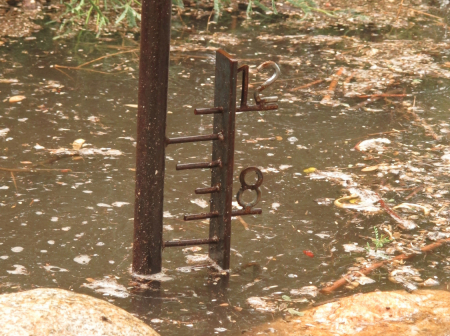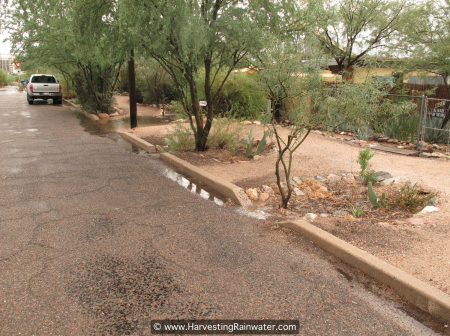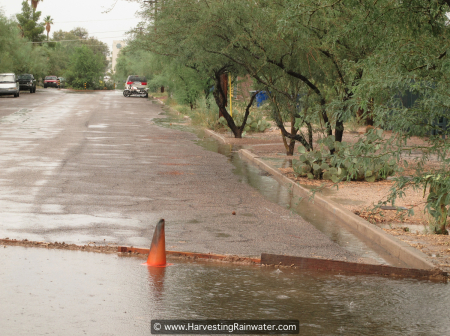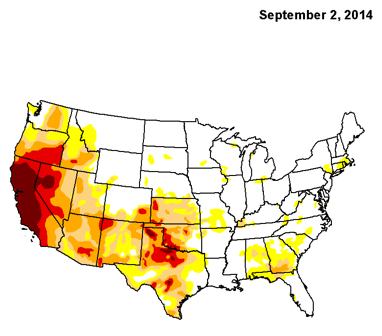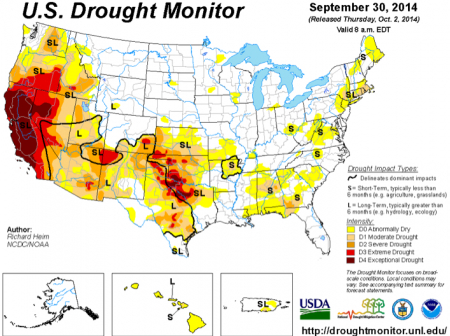Harvesting Rain from a 1,000+-Year Storm Event
by Brad Lancaster © 2014
www.HarvestingRainwater.com
Hurricanes Norbert and Odile caused horrible destruction in Baja, Mexico, while those of us further north were more fortunate. We got the abundant rainfall from the hurricanes on September 8 and 18, but not the violent winds. How many of us were prepared to use the rain for good in the drought-parched southwest? How many of us were unprepared?
As the rain fell, the lack of preparation for it was widespread. Water poured off roofs into yards then into the streets. Surging street creeks formed as additional water from parking lots, driveways, and schoolyards joined the flow. Properties downstream were flooded.
However, a growing number of people are seeing and managing the rain as a gift to invest, or to plant in a way that grows our community’s resilience.
Many in my neighborhood capitalize on the rainfall with street-side basins and in-street chicanes or rain gardens that freely irrigate food-bearing, street-shading, native vegetation (I show you how to do the same in my book series, Rainwater Harvesting for Drylands and Beyond).
Wanting to test the resiliency of these simple rain-planting basins, I decided to transform a 5-year, 1.5-inch (38-mm) rain event into a 1,000+-year, 19.5-inch (495-mm) rain event with a simple flow diversion. The results were fantastic.
In the public right-of-way, on the east side of the 1/8th-acre (0.05-ha) property I share with my brother’s family, we’ve put in five street-side basins that capture street runoff via openings we made in the street curb. Normally, these basins capture runoff only from our side of the street. The total catchment area is small (0.07 acre, or 0.03 ha) since our property and adjoining right-of-way are situated at a highpoint from which water typically drains away, and since we now retain all rain falling on our property (thus it no longer flows to the street). But the catchment area for the street-side basins increased dramatically when I built a temporary diversion to capture water from an adjacent, larger (0.84-acre or 0.2-ha) watershed across the street (see figure 1).
Click on the image below to see the full view.
I placed three wooden boards (a 4×6, 4×4, and 2×4) on the other side of the street with dirt to both hold them in place and to prevent water from flowing under the boards. This diverted water over the crown (raised section) in the middle of the road to our side of the street, where it quickly began to infiltrate into our street-side basins and an in-street water-harvesting/traffic-calming chicane in front of our property. I put a construction cone in front of the diversion, and stood in the street to direct any cars or cyclists around it (figures 2, 3, and 4).
It worked beautifully: About 95% of the runoff was diverted. Of that, 95% infiltrated into the basins (figures 5–8). The other 5% that overflowed our system was captured and infiltrated by the right-of-way basins in front of our neighbors’ properties (fig. 9).
By adding a catchment area 12 times the size of our normal catchment, we increased the volume of incoming water from a 1.5-inch (38-mm) rain event by a factor of 13 (1 for our normal catchment area plus 12 for the additional catchment area). This created conditions similar to those that would occur if a 19.5-inch (495-mm) rainstorm were to fall on our usual, much-smaller watershed (without the diversion). In our area, a rainfall of 4.6-inches (117-mm) in a 3-hour period equates to a 1,000-year storm event.1
No other water harvesters were left dry as a result of my actions, not even those on the other side of the street downstream of the diversion. All street-side and in-street water-harvesting basins filled in the peaks of the storm’s three pulses, and then infiltrated all the water within an hour. Those downstream filled from runoff from a non-water-harvesting property, its dirt parking lot, and the section of street below the diversion (figures 10 and 1).
Due to the rapid infiltration of rain into the soil of the basins, we would’ve been able to harvest a similar storm’s worth of water the next day. This would not be possible with rainwater tanks that would’ve been filled from the first storm (unless all the captured water were used before the next day’s rain). Thus water-harvesting earthworks are typically vastly superior to tanks at reducing downstream flooding.
When the rain ceased, I removed the wooden boards and shoveled and swept the dirt back into the right-of-way from which it came.
As before the hurricanes, drought continues (figures 11 & 12), but the water harvesters whose tanks are full and whose soils were deeply soaked do not feel the symptoms. Though just a week after the rains, the properties that drained—rather than harvested—the rainfall water were importing water via their drip-, sprinkler-, and hose-irrigation systems, as their soils were already drying out.
Are you ready to accept your local rain gifts and increase your community’s resilience? Or will you reject them, resulting in the worsening of conditions of droughts and floods?
REFERENCES:
1. hdsc.nws.noaa.gov/hdsc/pfds/pfds_map_cont.html?bkmrk=az
The math:
The surface-area dimensions (width x length) of our right-of-way (ROW) basins:
4’ x 24’ (= 96 ft2), 8’ x 11’ (= 88 ft2), 7’ x 20’ (= 140 ft2), 7’ x 6’ (= 42 ft2), 4’ x 25’ (= 100 ft2)
= total of 466 square feet (43.3 m2) of ROW basins
The surface area of one in-street chicane basin on our side of street: 10’ x 20’ (= 200 ft2)
The surface area of a second chicane basin on University Blvd (upstream of the diversion): 13’ x 23’ (= 299 ft2)
= total of 499 square feet (46.4 m2) of in-street chicane basins
Total surface area of basins (466 ft2) plus the chicane in front of our property along 9th Ave (200 ft2) = 666 ft2, or 0.015 acre (0.006 ha)
Total surface area of basins plus chicane in front of our property along 9th Ave (666 ft2) PLUS the second in-street chicane basin on the NE corner of 9th Ave and University Blvd (299 ft2) = 965 ft2, or 0.022 acre (0.009 ha)
Without the diversion, the normal street catchment area draining water to our street-side basins and one in-street chicane basin is 0.07 acre (figure 2).
Compare that 0.07-acre catchment area to our total basins-plus-one-chicane area of 0.015 acre, and you get a ratio of 4.7:1. In other words, 4.7 catchment-area units (draining water to our basins) to 1 infiltration/basin-area unit.
With the diversion, the enlarged, combined street (and parking lot) catchment area draining water to our street-side basins and two in-street chicane basins (0.07-acre normal street catchment area + 0.84-acre adjacent street-and-parking-lot catchment area) is 0.91 acre.
Compare that to our total basins-and-two-chicanes area of 0.022 acre, and you get a 41.4:1 ratio (catchment area to infiltration area).
By diverting water from the adjacent (0.84-acre) catchment from the east side of the street to join our (0.07-acre) catchment on the west side we added 12 times as much catchment area to our existing catchment area.
1.5 inches of rain x 12 times as much catchment area = equivalent of 18 inches of additional rainfall
Thus with the diversion, we were able to turn a 1.5-inch rain event into a 19.5-inch rainfall-harvest opportunity (1.5” + 18” = 19.5”).
But we need to use a runoff coefficient to get a more accurate estimate of how much of the rainfall actually runs off the surfaces onto which it falls. Most of the adjacent catchment area is impervious pavement and some rooftop (both of which have a typical runoff coefficient of 0.85 to 0.95, meaning 85 to 95% of the rain falling on those surfaces will run off). But a much smaller area of the catchment is dirt (typically having a runoff coefficient of 0.35 to 0.55).
So, we will estimate only 70% of the rain that falls on the 0.91-acre catchment actually runs off its surface.
Thus during a single 1.5-inch (38-mm) storm, we estimate we harvested 25,944 gallons (98,200 liters) in our seven right-of-way basins (the 5 street-side basins in front of our property, the in-street chicane basin in front of our property, and the in-street chicane upstream of the diversion).
How did we arrive at the figure of 25,944 gallons (98,200 liters) of harvested rain?
We converted the total 0.91-acre catchment area to square feet – 39,640 ft2
Then we multiplied the 39,640-ft2 catchment area by the rain falling on it in feet: (1.5 inches ÷ 12 inches/foot = 0.125 feet). 39,640 ft2 x 0.125 ft = 4,955 ft3 of rain.
We converted cubic feet to gallons by multiplying 4,955 ft3 by 7.48 gallons/ft3, which equals 37,063 gallons.
We then multiplied 37,063 gallons of rainfall by a 0.70 runoff coefficient, assuming 70% of the rain falling on the catchment surface ran off and into our basins. Thus we harvested an estimated 25,944 gallons of rainfall in a single 1.5-inch storm just in our five street-side basins and two in-street chicane basins.
That is over twice the volume of water our normal street catchment area (without diversion) would receive in a 1,000-year storm event:
4.05 to 5.63 inches of rain falling in a 6-hour period in our area would be a 1,000-year rainfall event. See the chart below the map at hdsc.nws.noaa.gov/hdsc/pfds/pfds_map_cont.html?bkmrk=az.
A 1,000-year rainfall event of 5.63 inches (0.469 ft) of rain falling in a 6-hour period on our normal 0.07-acre street catchment would equal 10,696 gallons…
0.07-acre street catchment converted to square feet is 3,049 ft2
3,049 ft2 x 0.469 ft of rain = 1,430 ft3
1,430 ft3 x 7.48 gallons/ft3 = 10,696 gallons
—.—.—.—.—.—.—.—.—.—.—.—.—.—.—.—.—
For the basis of these and more water-harvesting equations, see:
and
See the new, full-color, revised editions of Brad’s award-winning books
– available a deep discount, direct from Brad:

Volume 1
The book to start with as it shows you how to assess the potential of all your free, on-site waters, then create an integrated plan to harvest them in a way that benefits you, your neighborhood, and the larger watershed.

Volume 2
Shows you how to create street runoff-harvesting earthworks, and many other water-harvesting earthworks in other contexts.
Also gives you simple calculations to figure out:
- how much water you can harvest off a given catchment surface
- how to ideally size your earthworks to maximize their harvest
- how to estimate the cost of your earthworks
- and a whole lot more

